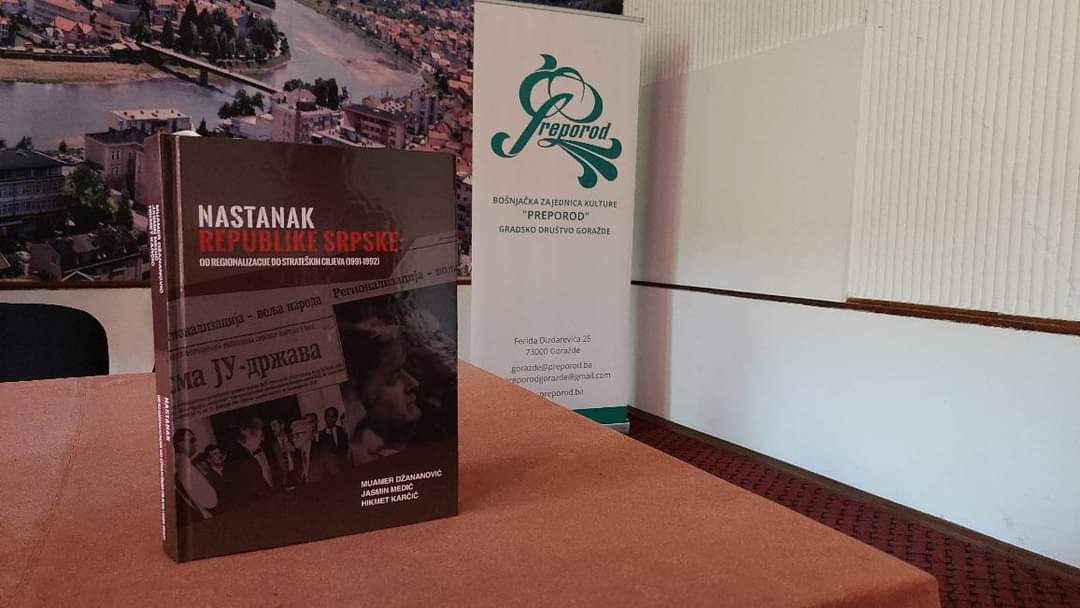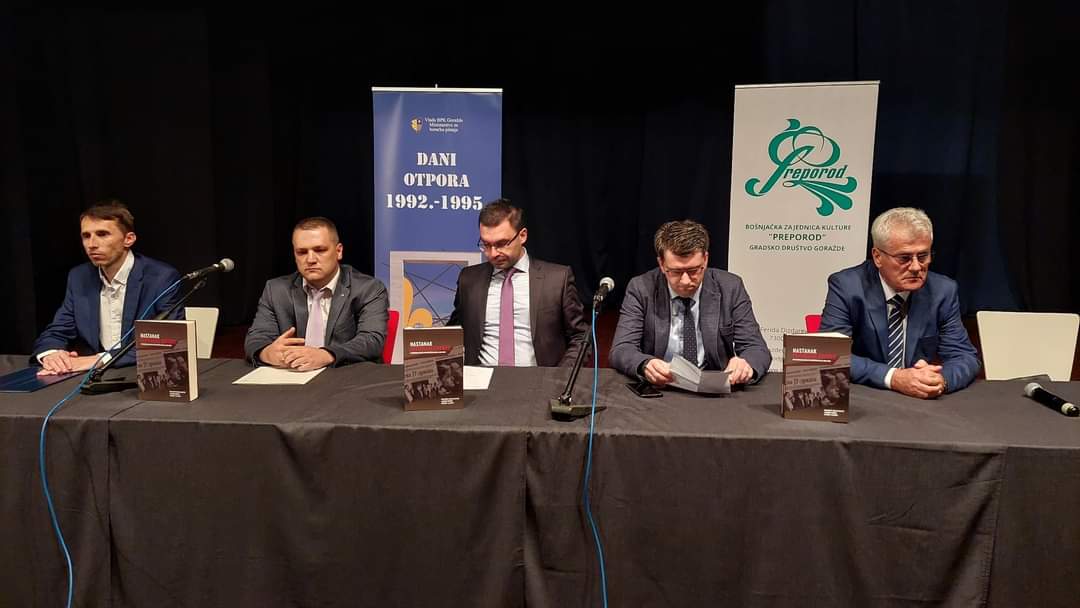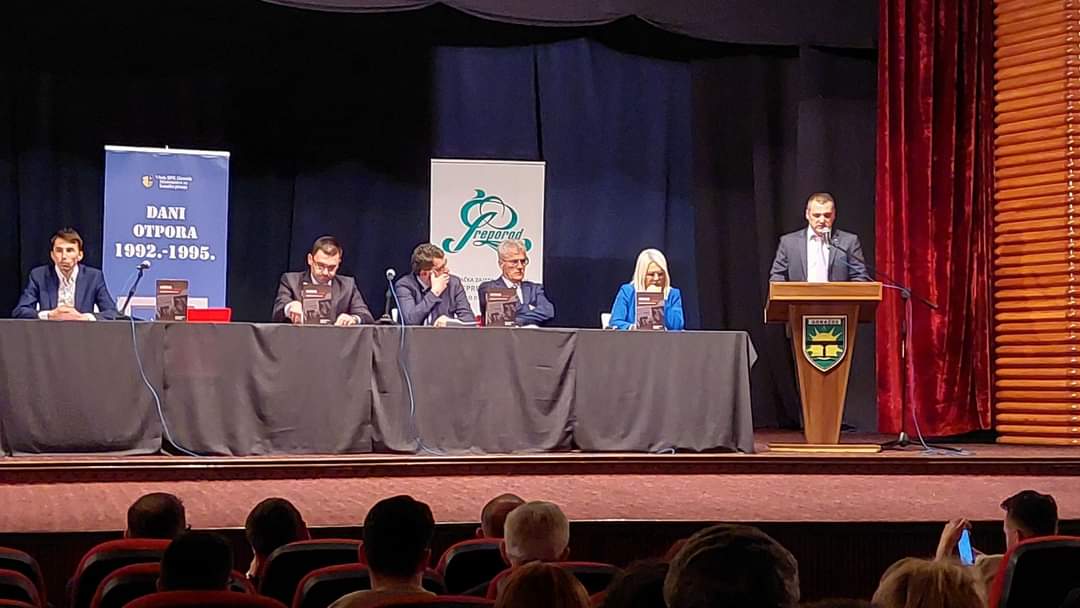The Bosnian cultural community Preporod in Goražde, under the auspices of the Ministry of Veteran Affairs BPK Goražde, organized the promotion of the book "Emergence of the Republic of Serbia: From Regionalization to Strategic Goals (1991-1992)", co-authored by Muamer Džananović, Jasmin Medić and Hikmet Karčić.
The work is chronologically organized into six chapters in which the authors analyze and synthesize the relevant literature and primary archival material, and provide insight into the most important events that preceded the proclamation of the so-called "Serbian Republic of Bosnia and Herzegovina", i.e. "Republic of Srpska" on January 9, 1992. The authors also provide a historical overview, followed by a detailed overview of continuous unconstitutional actions during 1991, but also of the period of final preparations for the operationalization of genocide and other crimes against humanity, which were made official on May 12, 1992, when at the 16th session the self-proclaimed "Assembly of the Serbian people in Bosnia and Herzegovina" adopted "Strategic goals of the Serbian people in Bosnia and Herzegovina".

The reviewer Rasim Muratović, Ermin Kuka and Almir Grabovica spoke about the book published by the Institute for the Research of Crimes against Humanity and International Law of the University of Sarajevo and the Institute of History of the University of Sarajevo.
"On the 70th page of this book, there is a statement by Ivan Stambolić, where he refers to a conversation with Vasa Čubrilović, who told him that a whole group of "immortals" is working tirelessly to feel Bosnia and Herzegovina, in order to somehow find a "goat track" that leads from Belgrade to Karlovac, but exclusively through Serbian villages and towns. I want to say that the conceptual design of the RS was made in Belgrade, that is, in Serbia, the executive design of the RS was made in the Sarajevo Holiday Inn hotel in the period from September 1991 to January 1992. The realization of the entire project lasted from April 1992 to August 1995. In the language of facts, this would mean the following: the Bosnian society and state were broken, a million people were expelled, 500 thousand people were wounded, over 100 thousand people were killed, 30 thousand women were raped, 300 concentration camps and 600 mass graves were organized. During that period, numerous crimes against humanity and international law were committed, including the genocide against Bosniaks. Because of this, and because of the final verdicts of international courts, the RS is also a genocidal creation," said Dr. Muratović.
Scientific truth
This scientific work is important for our history and for a complete understanding of what happened to us in that period, emphasizes dr. Ermin Kuka, one of the promoters.

"The special importance of this book is also the fact that it unmasks, deconstructs and demythologizes a narrative that we are constantly witnessing and exposed to by the Serbian and majority Serbian, both political and academic public. The book unmasks the narrative that, as time goes by, is more aggressive and intense, about who is to blame for the war conflict in the Republic of Bosnia and Herzegovina. It is about imposing the narrative that the Bosniaks started the war and that the motive was the murder of a Serbian wedding party at Baščaršija in Sarajevo, of course a relevant, scientifically documented answer should have been offered which is found in this book, which are relevant documents and documents from the other side". Kuka pointed out.
The editor of the book, Almir Grabovica, pointed out that he was most fascinated by the fifth chapter "Criminals in Connection", which contains intercepted telephone conversations between the Serbian political elite during 1991 and 1992, including numerous conversations between Slobodan Milošević and Radovan Karadžić.
"We should praise the employees of the State Security Service of the Republic of Bosnia and Herzegovina who, during the year 1991, eavesdropped on the telephone conversations of high-ranking Serbian representatives in Bosnia and Herzegovina and Serbia. Intercepted conversations from this period are the primary source for understanding the genocidal intent," Grabovica emphasized.
Muamer Džananović, one of the book's authors, among other things, spoke about the motives behind its creation and emphasized the importance of the documents they came across during scientific research.
From the SDS archive
"For the purposes of working on this study, in addition to the significant documentation of the Hague Tribunal, we came into possession of important documents which, I think, were not even in The Hague, and which Karadžić and their followers had previously read, we are talking about archival documentation of the SDS that was given to us helped us see all the facts objectively. We tried to write as simply as possible so that the work would be accessible to a wider audience, especially pupils and students," said dr. Muamer Džananović.
Co-author of the book dr. Jasmin Medić, research associate of the Institute of History of the University of Sarajevo, said that while writing he never thought about the saying that history repeats itself and that there was never a smaller difference between some processes from three decades ago and the political present. He explains that it is precisely because of the parallel between today and what is written in the book, a desire arose for it to see the light of day.
"If nothing else at this moment, I hope that it will serve all of us as a warning of what can happen if we do not take the political developments in the region and BIH seriously." Even today, as in 1991, nationalist circles, Serbian and Croatian, in Belgrade and Zagreb, have once again found common ground on the only thing they agree on, the division of Bosnia and Herzegovina. Even today, we are threatened by the exit of some police formations on some ethnic or entity lines, and today many are aware that "political Sarajevo" does not have effective control over all parts of Bosnia and Herzegovina, and that the patriotic bloc is again divided into several factions, which is why this country is in continuous dangers very similar to those in the early 1990s," warned Dr. Medic.

A lesson from the past
Waiting for someone from outside, from the International Community, to solve the political situation shows that we have not learned anything from the 90s, says dr. Medic.
"The number of the majority people is still being questioned in such circles and there is an undisguised attempt to reduce the majority people to a religious group. They tell us that we cannot even be equal with others, at the same time they are satisfied that we are placed in the so-called central Bosnian reserve as they announced to us in 1991 and 1992, and they are even more satisfied that we have become, to be completely honest, a statistical error without any decision-making rights in a smaller BiH entity. Anyone who thinks that any of us will be spared in their projections and plans is delusional. In the projections and plans, they do not divide us into rightists or leftists, into conservatives or liberals, they do not divide us into believers, agnostics or atheists, for them we are all the same, we convinced that in Prijedor in 1992, in Srebrenica in 1995, throughout Podrinje in 1992. in Sarajevo during the siege. Anyone who thinks that a process has ended in BIH and the Western Balkans is denied every day by nationalist actions in our environment. Whoever thinks so should not be surprised if in 30 years a new generation appears who will write about the tragedy of us who lived today and survived genocide and aggression. Let's just be honest, if that happens that time, unlike in the 90s, we will bear part of the responsibility because we didn't learn anything from our recent past", said Dr. Medic.
At the promotion attended by a large number of citizens of Goražde, it was pointed out that the authors received an offer from a reputable British publisher to publish the book in English.

(1).png)
(1).png)